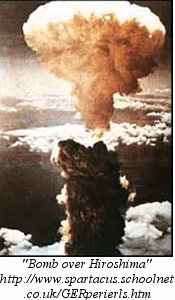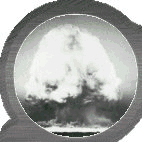| |
Hiroshima and Nagasaki
In December 194 the 509th composite group, their objective to train to drop the first atomic weapon on Japan. A committee of scientists and military leaders proposed the following cities to be targets for the bomb: Korkura, Hiroshima, Niigata, Kyoto, and Nagasaki. In the
 end Hiroshima was chosen as the target for the dropping of the first atomic bomb. On August 6, 1945 Colonel Tibbets lifted off his B-29, „Enola Gayš which was named after his mother, and began his flight to the target to drop the bomb on Hiroshima. „Little Boyš was aimed at the bridge in the middle of the city and it detonated just below 2,000 feet, and released the force of 17,000 tons of TNT. The blast and the following firestorm completely destroyed the surrounding 4.7 square miles of city, and left the city burning for days.
end Hiroshima was chosen as the target for the dropping of the first atomic bomb. On August 6, 1945 Colonel Tibbets lifted off his B-29, „Enola Gayš which was named after his mother, and began his flight to the target to drop the bomb on Hiroshima. „Little Boyš was aimed at the bridge in the middle of the city and it detonated just below 2,000 feet, and released the force of 17,000 tons of TNT. The blast and the following firestorm completely destroyed the surrounding 4.7 square miles of city, and left the city burning for days.
 In the end more that 60,000 people died and many more were injured. Some people estimated that out of all the casualties 20,000 were children. Since the Japanese didn't surrender three days later the more powerful atomic bomb, „Fat Manš, was dropped on Nagasaki. The bomb dropped on Nagasaki did even more damage. In the end, the emperor of Japan was forced to surrender, probably saving thousands, if not millions, of Japanese, American, and Russian lives that would be lost if a full scale war had been fought. That war was stopped at the cost of hundreds of thousands of civilian and military lives.
In the end more that 60,000 people died and many more were injured. Some people estimated that out of all the casualties 20,000 were children. Since the Japanese didn't surrender three days later the more powerful atomic bomb, „Fat Manš, was dropped on Nagasaki. The bomb dropped on Nagasaki did even more damage. In the end, the emperor of Japan was forced to surrender, probably saving thousands, if not millions, of Japanese, American, and Russian lives that would be lost if a full scale war had been fought. That war was stopped at the cost of hundreds of thousands of civilian and military lives.



|
|



